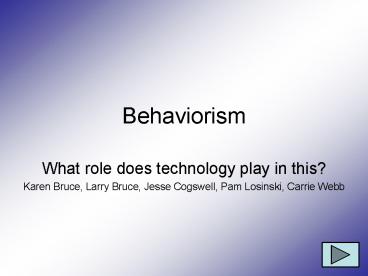Behaviorism - PowerPoint PPT Presentation
1 / 14
Title: Behaviorism
1
Behaviorism
- What role does technology play in this?
- Karen Bruce, Larry Bruce, Jesse Cogswell, Pam
Losinski, Carrie Webb
2
Basic Behaviorism
- Behavior and content can be learned through
reinforcements, associating new material to old
stimuli, and modeling (social learning) - Early behaviorists based learning modules around
contingencies of reinforcement - What are the circumstances surrounding
reinforcement? - What conditions are reinforcing behaviors (good
or bad)? - If the learning is not the desired outcome, how
we can change the reinforcer?
3
Basic Behaviorism
- As soon as behaviorism was developing, so was the
use of technology to prove the power of the
theory - Sydney L. Pressey, John B. Watson, B.F. Skinner,
pioneered techniques leading to computer assisted
instruction (CAI)
4
Computer Assisted Instruction
- Programmed instruction where material is broken
into frames - When the learner proves that the material has
been learned, he or she is given positive
reinforcement - New material is presented that builds upon the
old - Several Principles at Work
- Immediate feedback
- Complex learning through response chains
- Dialogue with instructor at every point
5
History of TechnologyAs It Pertains to
Behaviorism
- 1925 Multiple Choice Machine (S.L. Pressey)
- 1950s Program created by Norman Crowder trains
troubleshooters in US Air Force to find
malfunctions in electronic equipment - 1958 Skinners Rote-and-Drill Teaching Machine
6
More Recent Uses of Technology As It Pertains to
Behaviorism
- Computer Assisted Instruction Practices
- Accelerated Math personalized assignments
printed, bubble score sheets are scanned,
computer prints immediate scores, reports, and
feedback - Educational Online Games (e.g. www.brainPOP.com)
7
More Recent Uses of Technology As It Pertains to
Behaviorism
- Training or StAIR modules
- MIOSHA Bloodborne Pathogen training
- Classroom Instruction StAIR (e.g. Solving Systems
of Linear Equations) - Microsoft Flight Simulator for Educational Use
are just a few examples!
8
Which of the following scenarios is missing a
step in a behaviorist teaching approach?
Teacher lectures a topic, asks a question,
student answers correctly and receives candy
from the teacher.
Coach asks players to work hard in the big game,
they all do, and coach cancels sprints at the
next practice.
Phys. Ed. Teacher covers unit on baseball and
takes all students who hit a homerun to a Tigers
game.
Mom talks to young child about importance of
picking up his toys after he finishes playing
with them, child picks up after himself, and mom
hugs child.
9
What is Behaviorism?
- Is this presentation an example of using
technology for behaviorist principles?
YES
NO
10
Oh Yeah!
11
Bummer, remember...
- Computer Assisted Instruction
- Programmed instruction where material is broken
into frames - When the learner proves that the material has
been learned, he or she is given positive
reinforcement - New material is presented that builds upon the
old - Several Principles at Work
- Immediate feedback
- Complex learning through response chains
- Dialogue with instructor at every point
12
Congratulations! Youre right!
- There are several reasons this scenario doesnt
fit - Students may not find a trip to a Tigers
baseball game rewarding. - The baseball unit probably covered batting
strategies, - but hitting a homerun isnt a skill that can
be taught.
Moving on
13
Recall that Behaviorism is
- Behavior and content can be learned through
reinforcements, associating new material to old
stimuli, and modeling (social learning) - Early behaviorists based learning modules around
contingencies of reinforcement - What are the circumstances surrounding
reinforcement? - What conditions are reinforcing behaviors (good
or bad)? - If the learning is not the desired outcome, how
we can change the reinforcer? - As soon as behaviorism was developing, so was the
use of technology to prove the power of the
theory - Sydney L. Pressey, John B. Watson, B.F. Skinner,
pioneered techniques leading to computer assisted
instruction (CAI)
14
References
- Early CBI Systems and Their Antecedents Timeline,
http//argyll.epsb.ca/mkarstad/timeline/ - Learning Theories of Instructional Design,
http//www.usak.ca/education/coursework/802papers/
mergel/brenda.htm - Scheepers, Detken, Learning Theories Behavorism,
April 8, 2000, http//hagar.up.ac.za/catts/learner
/2000/scheepers_md/projects/loo/theory/behavior.ht
ml - Yovits, M.C. (Ed.), Advances in Computers, Vol.
18. New York Academic Press, 1979, pp. 173-229.
End Show































